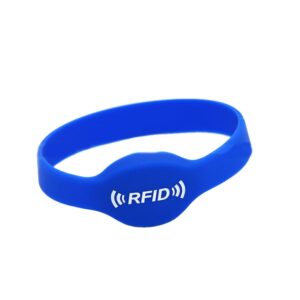INTRODUCTION
In this dynamic phase of accelerated digital and intellectual transformation, RFID Wristbands, commonly known as wrist tags, are invisibly permeating various realms of our day-to-day life. They serve as a proficient and effortless tool for authenticating identities and tracking data. The purpose of this article is to delve into the intricate workings of wrist tags, their unique applications across varied industries, and highlight the ease and benefits that this revolutionary technology has ushered in.

EXPLORING THE FUNCTIONING OF WRIST TAGS
The universally adopted wrist tags primarily utilize RFID (Radio Frequency Identification) technology. They comprise a band, an RFID chip, and an antenna. The chip is entrusted with the job of storing specific data, and the antenna is assigned the task of dispatching and receiving radio frequency signals. The bands are designed using a myriad of materials, such as silicone, PVC, and fabric, to cater to diverse application environments.
Its mode of operation is consistent with that of standard RFID tags. When the RFID Wristbands enters the reader’s proximity, it triggers the reader to emit a radio frequency signal. This signal is then intercepted by the antenna of the band, which subsequently relays the chip data back to the reader. Once the data is acquired, the reader then forwards it to the backend system for processing and storing. This quick and efficient process facilitates contactless data reading and identity verification.
THE WIDESPREAD APPLICATION OF WRIST TAGS IN MULTIPLE INDUSTRIES
The use of wrist bands has gained considerable traction across many sectors like healthcare, event and hotel management, owing to their convenience, security, and comfort.
Healthcare Industry
Patient Identification: RFID Wristbands aid in patient identification in hospitals, ensuring the precise validation of each patient’s details. By merely scanning these wristbands, medical personnel can conveniently access patients’ personal data and medical history, boosting operational efficiency and improving patient safety.
Tracking Medical Records: RFID Wristbands can chronicle a patient’s medical journey from admission to discharge, encompassing all treatment records and medication history. This technology enables efficient tracking and management of a patient’s treatment regime.
Event Management
Entry Verification: At large-scale events, for example, music festivals, sporting events, exhibitions etc., RFID Wristbands simplify the entry verification process. Attendees just need to sport these wristbands, and the staff can scan them for quick and easy verification, bypassing the traditional cumbersome process of physical ticket checking.
Payment and Purchase Management: RFID Wristbands also streamline the payment and purchase processes at event venues. Attendees can link these wristbands to their payment accounts and execute transactions during the event seamlessly.
Hospitality Industry
Room Access Control: RFID Wristbands provide hotel guests with a keyless access solution, improving safety and practicality. All guests need to do is bring their wristband close to the door lock to gain access, rendering the traditional key cards obsolete.
Universal Service Card: The scope of RFID Wristbands can be extended to include various hotel service offerings such as restaurant billing, SPA reservations, etc., providing a universal service solution and augmenting the overall guest experience.
Entrance Control for Designated premises
Personnel Localization and Surveillance: RFID Wristbands facilitate real-time localization and surveillance of personnel in higher security environments like child care and elderly care centers. This ensures personnel safety and streamlines management.
Restricted Area Entrance Control: RFID Wristbands can be programmed with different access rights. This enables only individuals with specific wristbands to gain access to particular areas like gyms, swimming pools, etc., boosting security and enhancing resource management efficiency.
As wrist tags serve different purposes across various industries, the RFID Wristbands we provide come equipped with chips offering varied functionalities. This provides users with the flexibility to choose from a variety of options to cater to the specific needs of different sectors.
BENEFICIAL ASPECTS OF WRIST TAGS
With its unique technological strengths, Wrist tags have significantly improved user experience and management in the industries where it has been applied. Let’s take a look at the primary advantages of Wrist Tags.
Enhancing Work Efficiency: Quick data readability offered by RFID Wristbands slashes manual operation time, intensifying work productivity.
Asserting Security: The data encryption algorithms of RFID Wristbands fortify information security, preventing data breaches and unauthorized access.
Optimizing Comfort and Convenience: Being easy to wear and comfortable, RFID Wristbands don’t impede regular activities. In addition, they facilitate a range of functions, contributing to enhanced user experience.
Ensuring Accurate Data Management: The precision in data archiving and management offered by RFID Wristbands minimizes human errors, ensuring data validity and consistency.
CONCLUDING THOUGHTS
RVing diverse industries with its RFID technology-based operation and a plethora of applications, Wrist Tag has become an indispensable player. It not only facilitates enhancing work productivity, ramping up security, providing convenience, and ensuring accurate data management but is also significantly transforming industries in the process. It’s hoped that this article provides an in-depth understanding of RFID Wristbands and motivates readers to adopt this cutting-edge technology in their respective fields.
